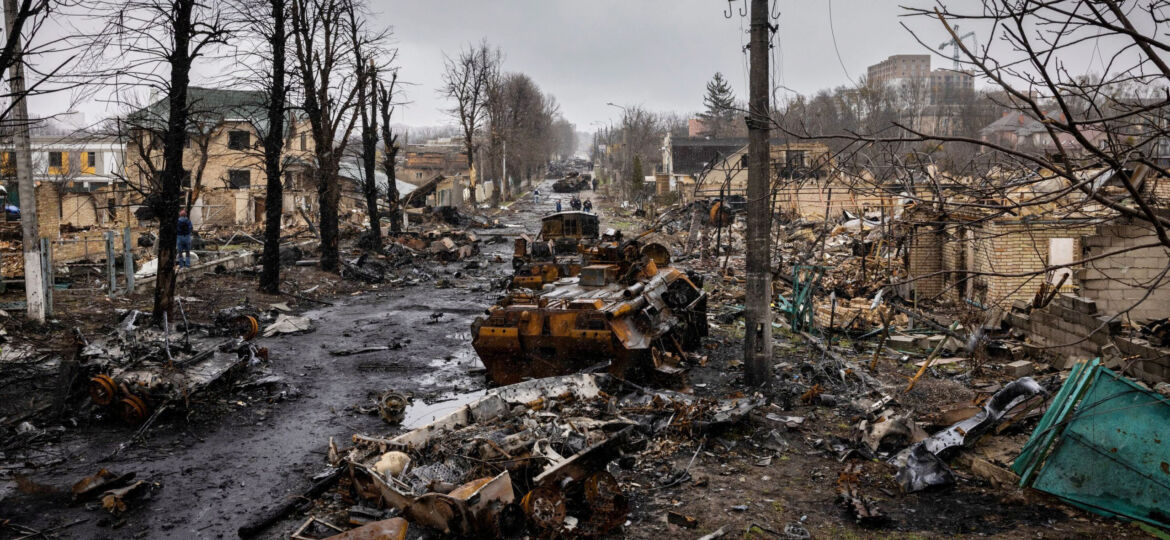On April 3 international media started publishing videos and pictures of the massacre that took place in Bucha, a Ukrainian town in Kiev’s region. According to reliable, first-hand reports, Russian forces occupied the town approximately from February 27 to March 31, and during that time frame they killed hundreds of civilians, some of whom were buried in mass graves.
As soon as videos and pictures showing the scale of the massacre started circulating, Russian authorities denied killing civilians in Bucha, and rather accused Ukraine of staging the whole situation “for the Western media.” In order to support this thesis, the Kremlin used two main narratives. The first one was based on the discrediting of the videos shot by the Ukrainian forces in Bucha after the withdrawal of Russian troops, which show a general situation of despair and several bodies in civilian clothes laying on the sides of the streets. According to Moscow, though, these videos would have been staged by Ukrainian forces, a theory proved by the fact that some corpses are actually moving. We debunked this false narrative in a previous Edmo article.
The second element used by Russian propaganda to deny the country’s responsibilities in Bucha is based on the timeline of events. While this narrative is more difficult to debunk, it’s not impossible: international media aggregated all the available pieces of information, analyzed videos and satellite images, and proved the falsehood of the Russian thesis.
Russia’s timeline
On April 3, the Russian Ministry of Defense stated on its official Telegram channel that Russian troops had abandoned Bucha on March 30, but videos of atrocities started appearing on social media on April 3, four days later. The Kremlin thus accused Ukraine of having used that timeframe to stage the massacre. (Actually, videos and pictures showing dead bodies in the streets of Bucha started spreading earlier, on April 1. On that same day, Bbc journalists were able to enter the town, and witnessed the presence of corpses and burned tanks.)
As explained by Italian fact-checkers at Facta, the timeline of events that took place in Bucha between March 30 and April 2 is still unclear, also because the Bucha’s city council and the town’s Mayor provided contradictory information.
Before analyzing why the Russian version of the events doesn’t add up, let’s see the timeline provided by Ukrainian authorities, which also presents some inconsistencies.
Ukraine’s (contradictory) version
On March 30 the military authorities of Kiev’s region labeled Bucha, Vorzel and Gostomel (two other neighboring towns) as particularly dangerous areas, where infrastructures and residential buildings had been hit by bombings and Russian forces “kept terrifying the local population.”
The following day, on March 31, the administration said that Bucha remained under Russian control. Things changed on April 1: while the Secretary of the Bucha city council said that the town remained “dangerous” and “under occupation,” even though Russian troops were starting to leave, Bucha’s Mayor Anatoliy Fedoruk published a Facebook post saying that the town had been liberated on March 31.
The differences between these communicative approaches remains unclear: on the one hand, the city council was still warning citizens to be cautious, while the Mayor said the town had already been liberated. However, it’s understable that information coming in real time from such complex and critical contexts could be fragmentary or contradictory, even when the sources are considered to be reliable.
However, Fedoruk had started denouncing the presence of dead bodies and mass graves days before, and the Facebook page of the city council published several posts about the town’s progressive liberation. It’s likely that, on March 31, the Mayor anticipated with his messages the actual liberation of Bucha.
According to several international media, Russian forces started withdrawing from Bucha between March 30 and March 31, and on April 2 Ukrainian vice-Minister of Defense Ganna Maliar announced that Ukraine had regained control over “Irpin, Gostomel, and the whole Kiev region.”
While Ukraine’s timeline is not completely clear, but overall has been confirmed by local authorities and international media, Russia’s version of events has been debunked. Let’s see why.
Debunking propaganda
Investigations by independent media proved that the Kremlin’s timeline thesis doesn’t add up. On April 4, the New York Times published an in-depth story about what happened in Bucha. The Visual Investigations team at the newspaper conducted an analysis of videos and satellite images provided by a private company, showing that many of the victims had been killed “more than three weeks” before news about the massacre started spreading on April 2, “when Russia’s military was in control of the town.” This “rebuts claims by Russia that the killing of civilians in Bucha, a suburb of Kyiv, occurred after its soldiers had left the town,” the Times wrote.
Bellingcat, a journalistic project specialized in Osint and investigative reporting, also debunked Russia’s version of the events.
In conclusion
As soon as the Russian forces withdrew from the Ukrainian town of Bucha, around April 1, pictures and videos started circulating showing dozens of dead bodies on the sides of the streets and in mass graves. Russia quickly denied any responsibility in the killing of civilians, and labeled the images as deliberately staged by Kiev “for the Western media.”
One of the most contested elements of this story is the timeline of events, which was presented differently by Ukrainian and Russian authorities. But while Ukraine’s version has overall been confirmed by international media – even though it did present some contradictions –, Russia’s claims have been debunked.
The Kremlin, in fact, stated that bodies were not there when its troops left Bucha, but instead they were actors placed by Ukrainians to stage the massacre and blame Russia for it. This theory has been proved to be completely false by several international media, among which the New York Times, which analyzed satellite videos and images from before and after the liberation of Bucha, showing that corpses were already there when the town was under Russian control.
Laura Loguercio
Tommaso Canetta
Photo: Flickr, Manhhai
